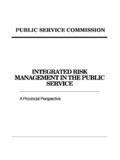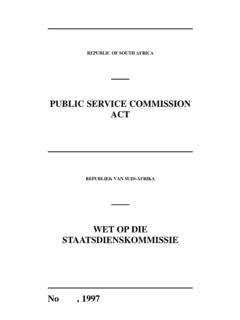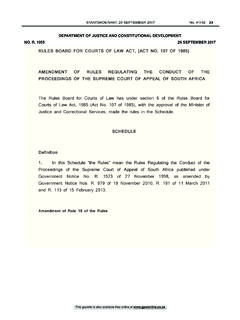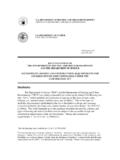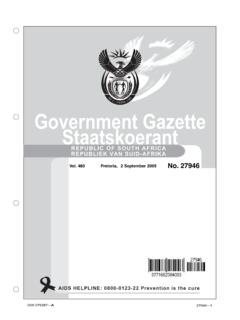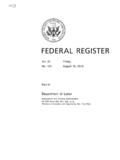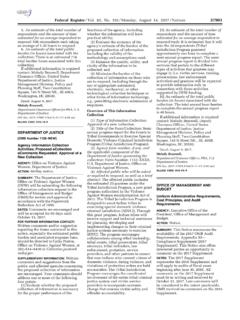Transcription of Compliance with the Promotion of Administrative …
1 Compliance with the Promotion of Administrative justice Act, 2000. (Act No. 3 of 2000). Published in the Republic of South Africa by: THE PUBLIC SERVICE COMMISSION (PSC). Commission House Cnr. Hamilton & Ziervogel Streets Arcadia, 0083. Private Bag x121. Pretoria, 0001. Tel. (012) 352-1000. Fax (012) 325-8382. Website. National Anti-Corruption Hotline Number: 0800 701 701 (Toll-Free). Compiled by: Branch: Monitoring and Evaluation Distribution by: Directorate: Communication and Information Services ISBN: 0-621-36973-x RP: 265/2006.
2 I Foreword The Promotion of Administrative justice Act, 2000 (Act No. 3 of 2000) (PAJA), is pioneering legislation that intends changing the way government interacts with the people it serves. It creates ways of enforcing the right to be treated fairly in Administrative actions. The PAJA seeks to protect the public from unlawful, unreasonable and procedurally unfair Administrative decisions. It is a law that gives people affected by Administrative decisions the right to be informed that a decision is to be taken, to be given reasons for decisions and to have decisions reviewed in court.
3 If it protects people from unlawful, egotistical and domineering law enforcers, then the Act is necessary. Principles such as openness, transparency and accountability emphasise the importance of the PAJA for citizens and the Public Service. Just knowing it exists makes the holders of information and decision makers think twice. It will become more effective if it is better applied and more widely promoted. If we are thorough in each and every interaction with the public we will avoid future problems.
4 These viewpoints were articulated during the assessment. They send a clear message about the transformation of the Public Service. A culture of Compliance with the constitutional values of openness, transparency and accountability is required to ensure that the implementation of the PAJA is more than merely legalistic Compliance . However, there are of cials who say we do not ask for trouble, and citizens are therefore not informed of their right to appeal Administrative decisions. This report provides useful information to government departments regarding the status of implementation of the PAJA.
5 The Department of justice and Constitutional Development (DoJ&CD) and the Public Service Commission (PSC) hope that the report will enhance the ability of departments to implement the PAJA more effectively, creating awareness in innovative ways of the rights of citizens under the Constitution. ii The PSC and the DoJ&CD are most grateful to the German Technical Cooperation Agency (GTZ) for funding the research. We trust that this report will add value to the current work of Public Service managers throughout South Africa.
6 Yours sincerely Prof Stan S Sangweni Ms B S Mabandla Chairperson: Public Service Commission Minister: Department of justice and Constitutional Development iii Contents Glossary vii Executive Summary viii Chapter one: Background and introduction 1. The Promotion of Administrative justice Act 2. Aims and objectives of research 2. Chapter two: Research Method 3. Overall strategy 4. Research instrument 4. Research implementation 4. Chapter three: Acknowledgements 6. Chapter four: Awareness of the PAJA 8.
7 Impact of training: Comparison between institutions where training had been provided and where no training had been provided 9. In a national department (Department of Home Affairs) 9. In a provincial department where training had been provided (Northern Cape Department of Social Development) 9. In a provincial department where training has not been provided (Limpopo Department of Health and Social Development) 10. In a local authority where training had been provided (Cape Town) 10. In Civil Society Organisations 11.
8 Iv Chapter five: Review of Administrative Practices 12. In a national department (Department of Home Affairs) 13. In a provincial department where training has been provided (Northern Cape Department of Social Development) 14. In a provincial department where training had not been provided (Limpopo Department of Health and Social Development) 15. In a local authority (Cape Town) 17. Chapter six: Institutional Efforts to Ensure Compliance with the PAJA 20. In a national department (Department of Home Affairs) 21.
9 In a provincial department where training had been provided (Northern Cape Department of Social Development) 21. In a provincial department where training had not been provided (Limpopo Department of Health and Social Development) 22. In a local authority where training had been provided (Cape Town) 22. Chapter seven: Civil Society Responses 24. Awareness 25. Practices 25. Compliance 26. Chapter eight: Overview of the Research Findings and Implications 27. The degree to which public servants and staff in Civil Society Organisations are aware of the Act 28.
10 The extent to which Administrative practices meet the standards of fairness stipulated in the PAJA 28. How far Public Service organisations have gone in systematically implementing the Act 28. v Contents (Continued). Chapter nine: Possible Strategies to Increase PAJA Compliance 29. Awareness and communication 30. Training 30. Integration with other government programmes 31. Integration with business processes 31. Chapter ten: Monitoring and Evaluation 32. A monitoring and evaluation strategy 33. Additional research 33.




